Local Scour around Side-by-Side Double Piers in Channel Bends under Ice-Covered Conditions—An Experimental Study
Abstract
1. Introduction
2. Materials and Methods
2.1. Experimental Setup
2.2. Experiment Procedures
- (1)
- Before each experimental run, the model bridge piers were installed at the bend apex cross-sections. Then, the channel bed was filled with sediment and leveled carefully before each experimental run. By adjusting the upstream weir head, the flume was then slowly filled with water to avoid the initial scour. The incoming flow to the flume was then gradually adjusted to the designated flow rate.
- (2)
- At each cross-section, three pressure gauges were installed to check the water level in the flume. To reach the specified water depth in the flume, the tailgate at the downstream end of the flume was gradually adjusted.
- (3)
- Under an ice-covered flow condition, the Reynolds number Re was calculated using Equation (2).where ρw = the mass density of the water; μ = the dynamic viscosity of the water; and d = the characteristic length. The hydraulic radius is used under an ice-covered condition.For all experimental runs, the Reynolds number was higher than 11,250. Therefore, the flows for all experimental runs can be considered fully developed turbulence.
- (4)
- The model ice cover was placed on the water surface along the bend channel from CS-3 to CS-26. Then, the experiment under this condition began. The depth of the scour holes around side-by-side double piers was measured once every five minutes during the first half hour then once every ten minutes during the 2nd half-hour, and, finally, once every 30 min until the end of each experiment run.
- (5)
- After the experiment achieved the equilibrium condition, the maximum depth of the scour hole was reached. The Acoustic Doppler Velocimeter (ADV) was used to measure flow velocities in front of the piers, as shown in Figure 3. After all the data for the flow velocity were acquired, both the ADV and model ice cover around the piers were carefully removed. Then, the bathymetry of the scour holes and deposition dunes around the piers was measured carefully using a point gauge with an accuracy of 0.1 mm.
3. Results
3.1. Temporal Variation of Scour Holes
3.2. Comparison of Local Scour under Open Channel and Ice-Covered Flow Conditions
3.3. Effect of Densimetric Froude Number on Local Scour
3.4. Effect of the Pier Spacing on Local Scour
3.5. Local Scour at Different Locations of the Side-by-Side Piers
3.6. Formulas for Determining the Maximum Local Scour Depth
4. Conclusions
- (1)
- The maximum depth of scour holes around the convex pier is more substantial than that around the concave pier. The densimetric Froude number clearly has prominent effects on the maximum depth of scour holes around the convex pier. The relative local scour depth around side-by-side double piers in the bend flume increases with increase in the Frd. The slope of the fitting line between the scour depth and Frd and relative local scour depth around the convex bank pier is steeper compared to that for the concave bank pier, suggesting that the local scour depth at the convex bank pier is more affected by the Frd.
- (2)
- In a straight channel, the relative maximum scour depth around piers decreased as the pier spacing increased. However, results in a bend channel were different from those acquired in the straight channel when the side-by-side double piers were placed at the bend apex cross-section. The relative scour depth around the convex bank pier in the S-shaped flume increases as the pier spacing increases, but it decreases around the concave bank pier as the pier spacing increases.
- (3)
- The maximum depth of scour holes around the convex bank pier at different bend apex cross-sections did not change much when all other factors were constant. In contrast, the maximum depth of scour holes around the concave bank pier decreased as the bend increased toward downstream.
- (4)
- The formula for determining the maximum scour depth around both convex bank piers and concave bank piers has been established considering the densimetric Froude number, pier spacing, and the ratio of the cumulative turning angle of the flow from the upstream control cross-section to the cross-section where the piers are located (α) to the angle of the bend where the piers are located (β). The results calculated using the proposed equations agree well with those of laboratory experiments.
Author Contributions
Funding
Data Availability Statement
Acknowledgments
Conflicts of Interest
References
- Ashton, G.D. River ice. Ann. Rev. Fluid Mech. 1978, 10, 369–392. [Google Scholar] [CrossRef]
- Beltaos, S.; Miller, L.; Burrell, B.C.; Sullivan, D. Formation of breakup ice jams at bridges. J. Hydraul. Eng. 2006, 132, 1229–1236. [Google Scholar] [CrossRef]
- Sui, J.; Wang, J.; He, Y.; Krol, F. Velocity profiles and incipient motion of frazil particles under ice cover. Int. J. Sediment Res. 2010, 25, 39–51. [Google Scholar] [CrossRef]
- Ettema, R.; Zabilamsky, L. Ice influences on channel stability: Insights from Missouri’s fort peck reach. J. Hydraul. Eng. 2004, 130, 279–292. [Google Scholar] [CrossRef]
- Chiew, Y.M.; Melville, B.W. Local scour around bridge piers. J. Hydraul. Res. 1987, 25, 15–26. [Google Scholar] [CrossRef]
- Melville, B.W.; Chiew, Y.M. Time scale for local scour at bridge piers. J. Hydraul. Eng. 1999, 125, 59–65. [Google Scholar] [CrossRef]
- Oliveto, G.; Hager, W.H. Temporal evolution of clear-water pier and abutment scour. J. Hydraul. Eng. 2002, 128, 811–820. [Google Scholar] [CrossRef]
- Aksoy, A.O.; Bombar, G.; Arkis, T.; Guney, M.S. Study of the time-dependent clear water scour around circular bridge piers. J. Hydrol. Hydromech. 2017, 65, 26–34. [Google Scholar] [CrossRef]
- Fael, C.; Lança, R.; Cardoso, A. Effect of pier shape and pier alignment on the equilibrium scour depth at single piers. Int. J. Sediment Res. 2016, 31, 244–250. [Google Scholar] [CrossRef]
- Ataie-Ashtiani, B.; Beheshti, A.A. Experimental investigation of clear-water local scour at pile groups. J. Hydraul. Eng. 2006, 132, 1100–1104. [Google Scholar] [CrossRef]
- Kim, H.S.; Nabi, M.; Kimura, I.; Shimizu, Y. Numerical investigation of local scour at two adjacent cylinders. Adv. Water Resour. 2014, 70, 131–147. [Google Scholar] [CrossRef]
- Malik, R.; Setia, B. Interference between pier models and its effects on scour depth. SN Appl. Sci. 2020, 2, 68. [Google Scholar] [CrossRef]
- Bordbar, A.; Sharifi, S.; Guo, Z.; Hemida, H. Estimating the equilibrium scour depth around two side-by-side piers with different spacing ratios in live-bed conditions. Ocean Eng. 2022, 257, 111641. [Google Scholar] [CrossRef]
- Mamoon, A.A.; Zhao, M.; Wu, H.; Keshavarzi, A. Experimental investigation of local scour around two submerged short square piles under tandem, side-by-side and staggered arrangements in steady current. Ocean Eng. 2022, 261, 112156. [Google Scholar] [CrossRef]
- Ackermann, N.L.; Shen, H.T.; Olsson, P. Local scour around circular piers under ice covers. Ice in the Environment. In Proceedings of the 16th IAHR International Symposium on Ice, Dunedin, New Zealand, 2–6 December 2002. [Google Scholar]
- Hains, D.; Zabilansky, L. Laboratory Test of Scour under Ice: Data and Preliminary Results; U.S. Army Engineer Research and Development Center, Cold Regions Research and Engineering Laboratory: Hanover, NH, USA, 2004; p. 182. [Google Scholar]
- Hains, D.; Zabilansky, L. The Effects of river ice on scour and sediment transport. In Proceedings of the CRIPE 13th Workshop on the Hydraulics of Ice Covered Rivers, Hanover, NH, USA, 15–16 September 2005. [Google Scholar]
- Wu, P.; Hirshfield, F.; Sui, J.; Wang, J.; Chen, P. Impacts of ice cover on local scour around semi-circular bridge abutment. J. Hydrodyn. 2014, 26, 10–18. [Google Scholar] [CrossRef]
- Wu, P.; Balachandar, R.; Sui, J. Local scour around bridge piers under ice-covered conditions. J. Hydraul. Eng. 2016, 142, 04015038. [Google Scholar] [CrossRef]
- Wang, J.; Li, Z.; Cheng, T.; Sui, J. Experimental study on local erosion of piers under ice cover with time. J. Hydraul. Eng. 2021, 52, 1174–1182. (In Chinese) [Google Scholar]
- Wang, J.; Wang, K.; Fang, B.; Sui, J. A revisit of the local scour around bridge piers under an ice-covered flow condition—An experimental study. J. Hydrodyn. 2021, 33, 928–937. [Google Scholar] [CrossRef]
- Wang, J.; Hou, Z.; Sun, H.; Fang, B.; Sui, J.; Karney, B. Local scour around a bridge pier under ice-jammed flow condition—An experimental study. J. Hydrol. Hydromech. 2021, 69, 275–287. [Google Scholar] [CrossRef]
- Hu, H.; Wang, J.; Cheng, T.; Hou, Z.; Sui, J. Channel bed deformation and ice jam evolution around bridge piers. Water 2022, 14, 1766. [Google Scholar] [CrossRef]
- Sang, L.; Wang, J.; Cheng, T.; Hou, Z.; Sui, J. Local Scour around Tandem Double Piers under an Ice Cover. Water 2022, 14, 1168. [Google Scholar] [CrossRef]
- Namaee, M.R.; Sui, J. Local scour around two side-by-side cylindrical bridge piers under ice-covered conditions. Int. J. Sediment Res. 2019, 34, 355–367. [Google Scholar] [CrossRef]
- Namaee, M.R.; Sui, J.; Wu, Y.; Linklater, N. Three-dimensional numerical simulation of local scour around circular side-by-side bridge piers with ice cover. Can. J. Civ. Eng. 2021, 48, 1335–1353. [Google Scholar] [CrossRef]
- Chiew, Y.M. Local Scour at Bridge Piers. Ph.D. Thesis, Auckland University, Auckland, New Zealand, 1984. [Google Scholar]
- Sheppard, D.M.; Melville, B.; Demir, H. Evaluation of existing equations for local scour at bridge piers. J. Hydraul. Eng. 2014, 140, 14–23. [Google Scholar] [CrossRef]
- Namaee, M.R.; Sui, J. Impact of armour layer on the depth of scour hole around side-by-side bridge piers under ice-covered flow condition. J. Hydrol. Hydromech. 2019, 67, 240–251. [Google Scholar] [CrossRef]

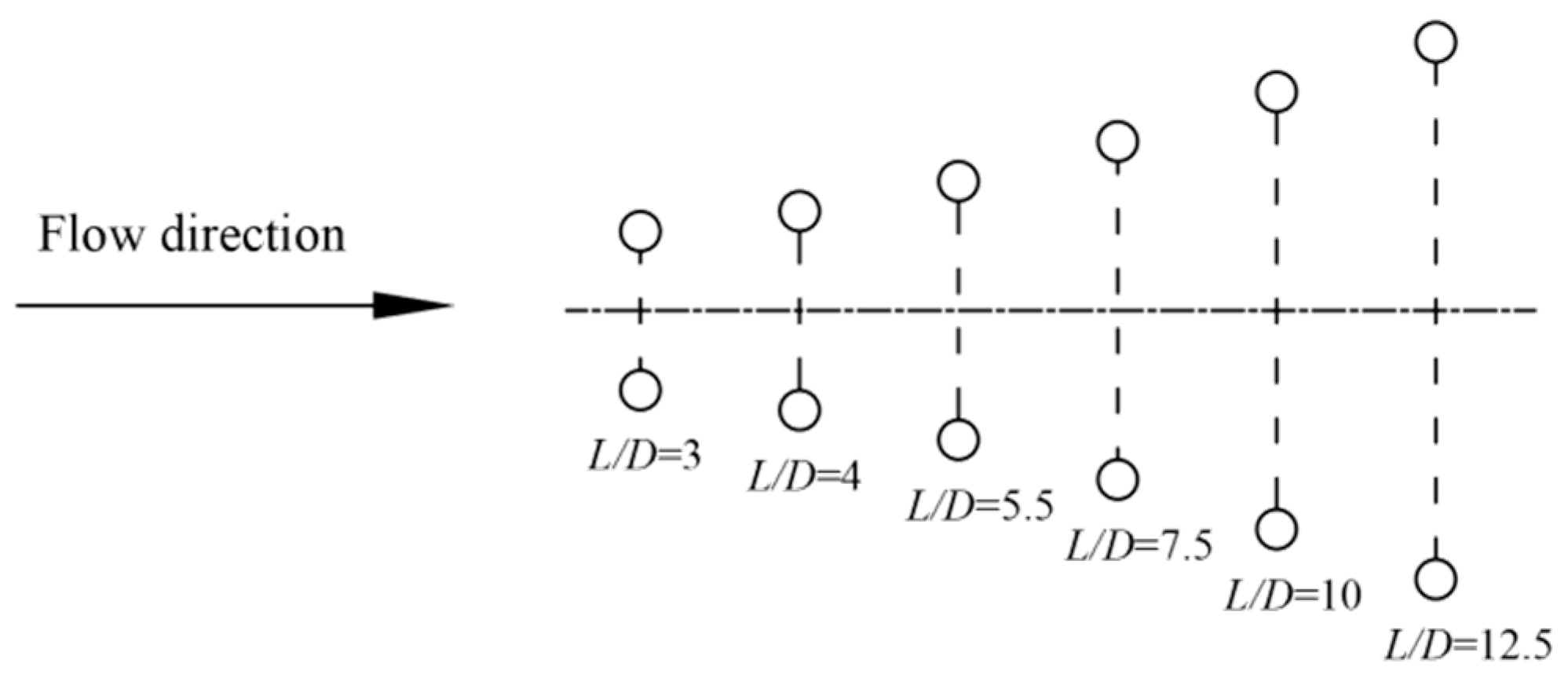
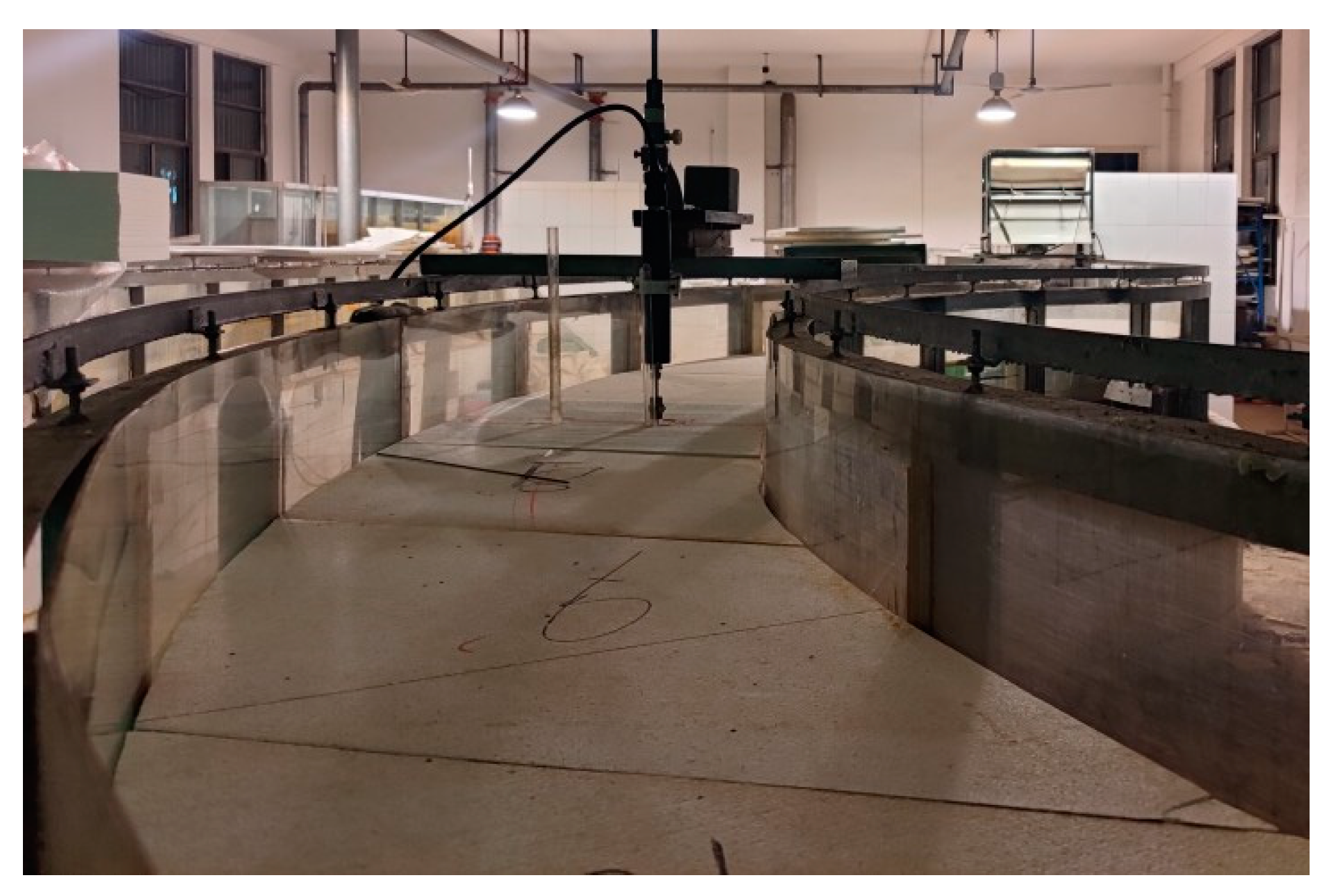


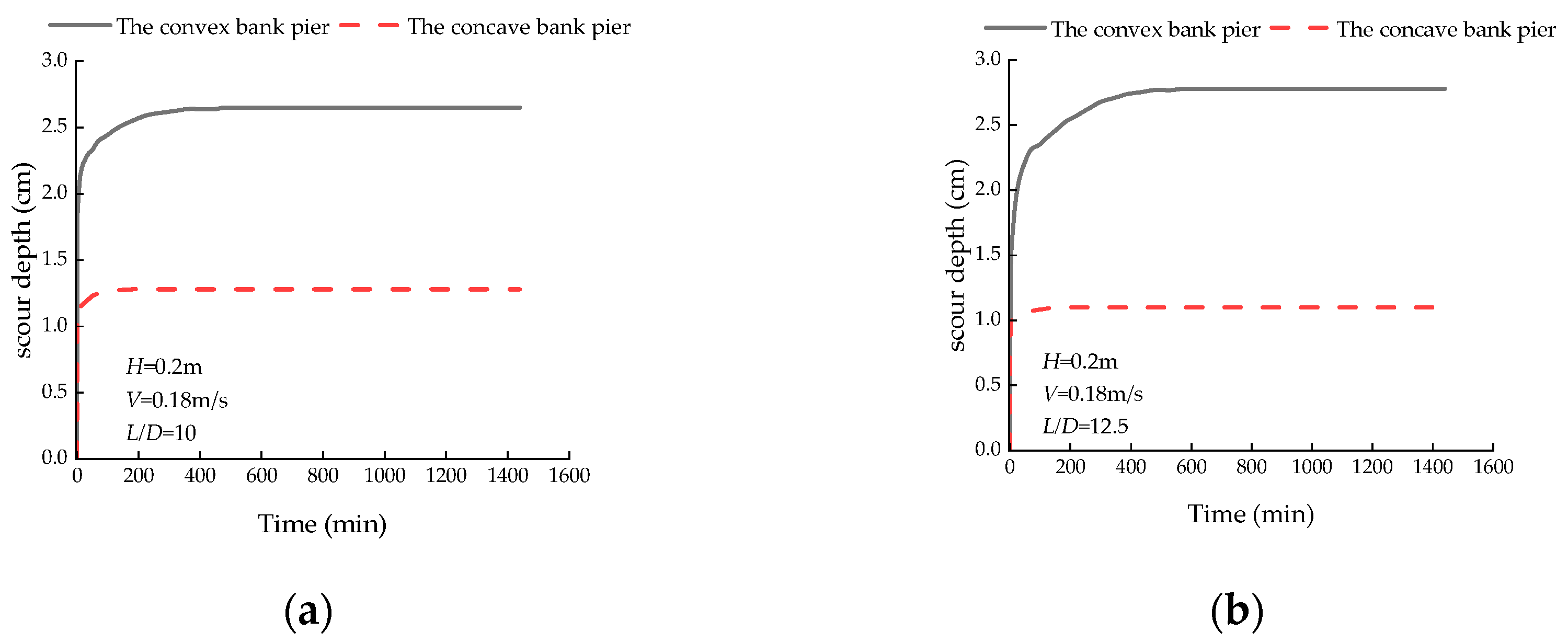
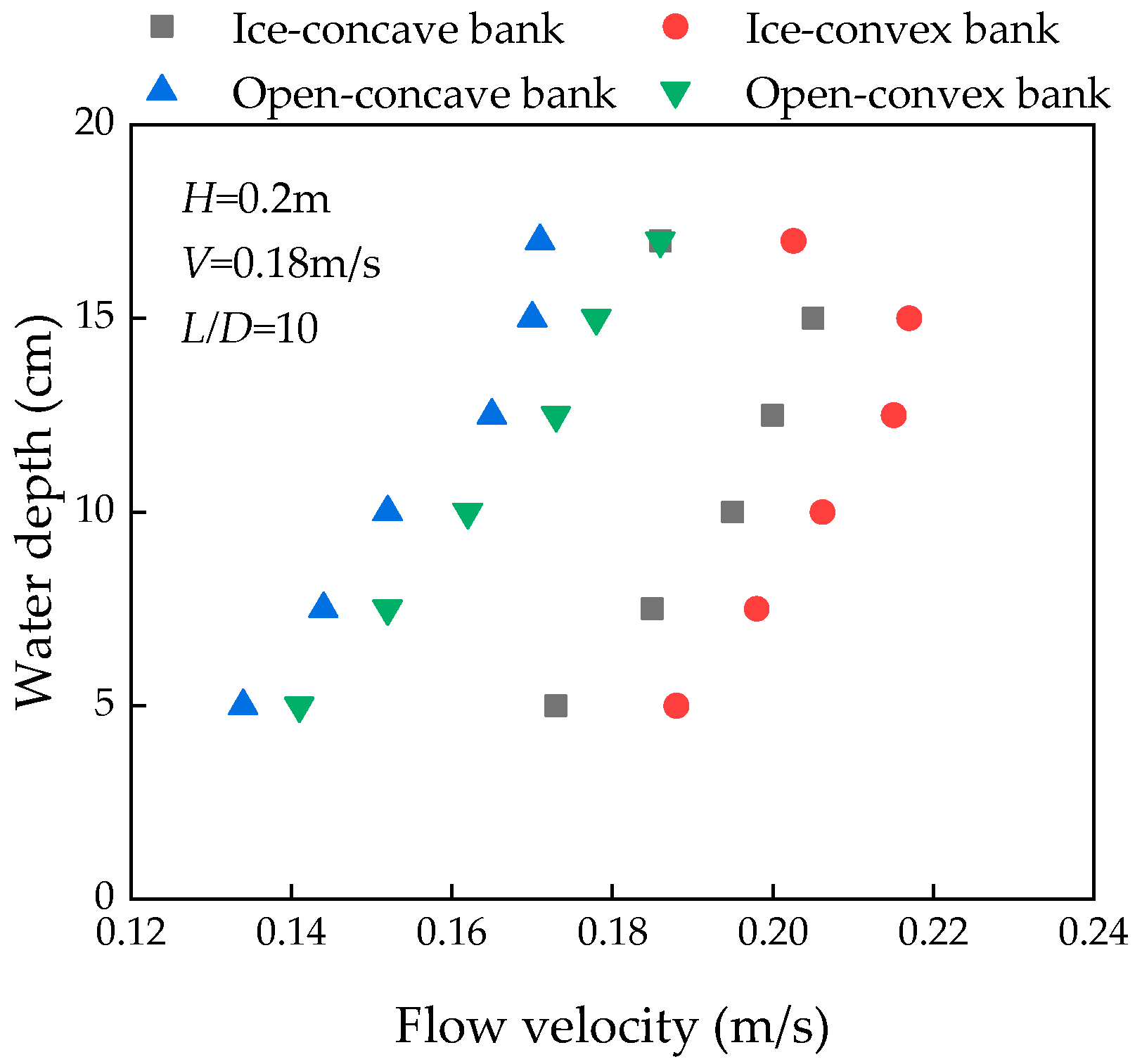
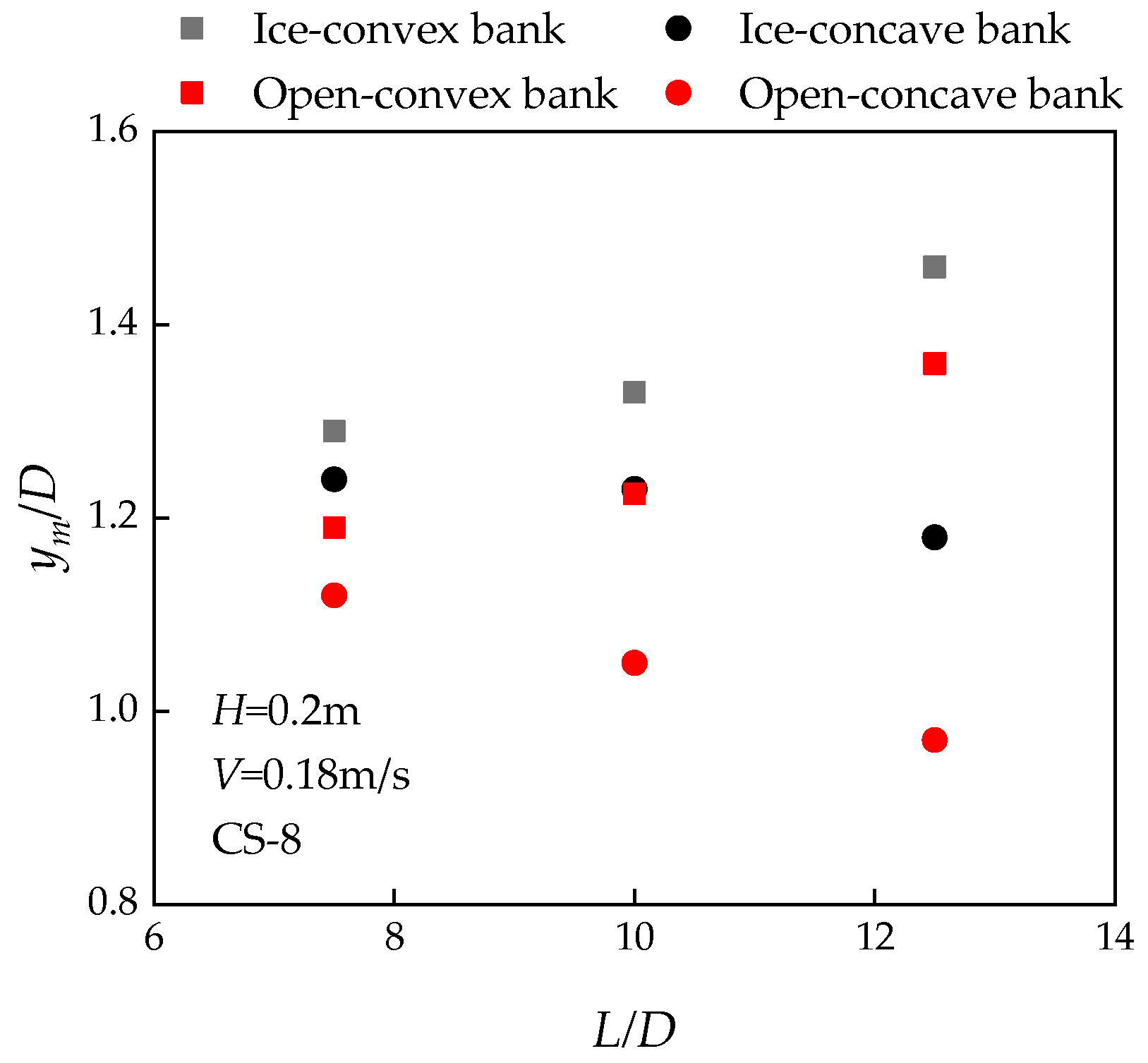
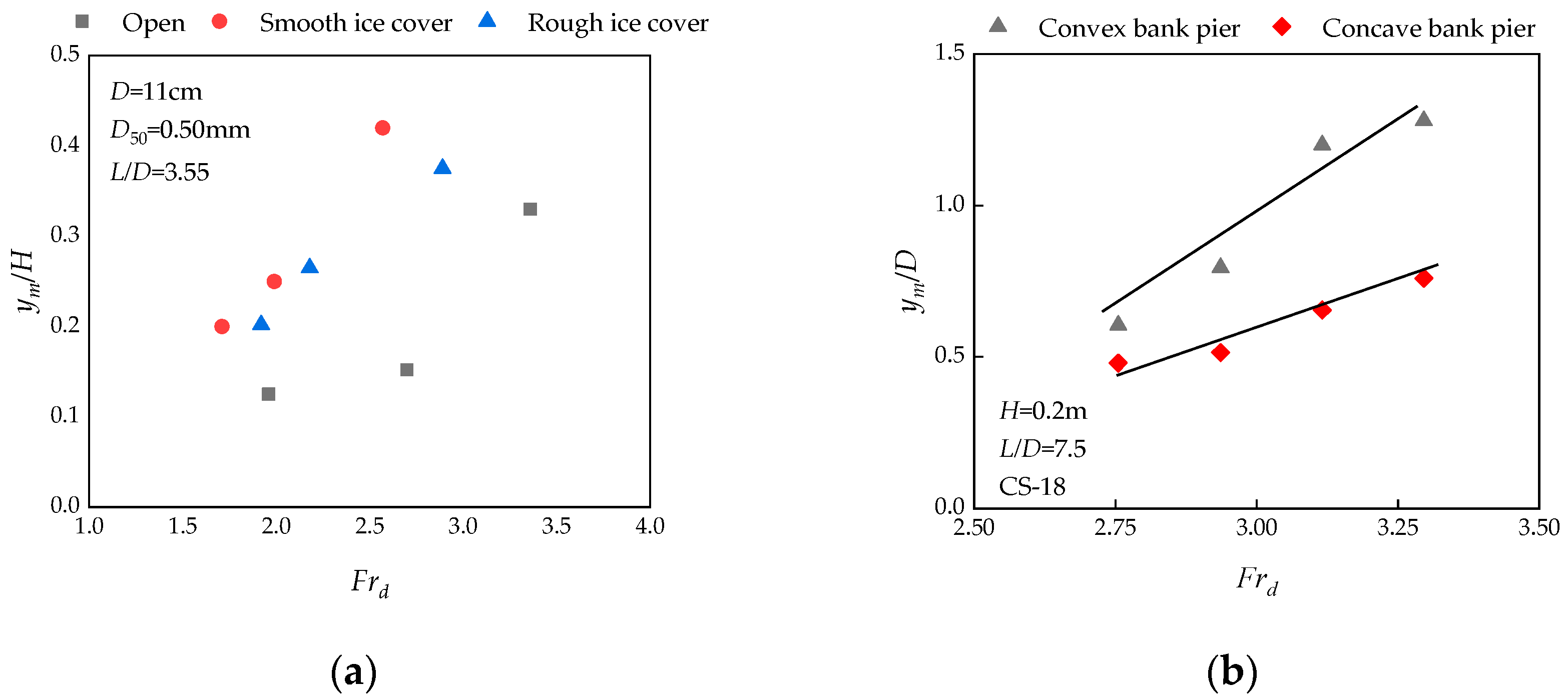

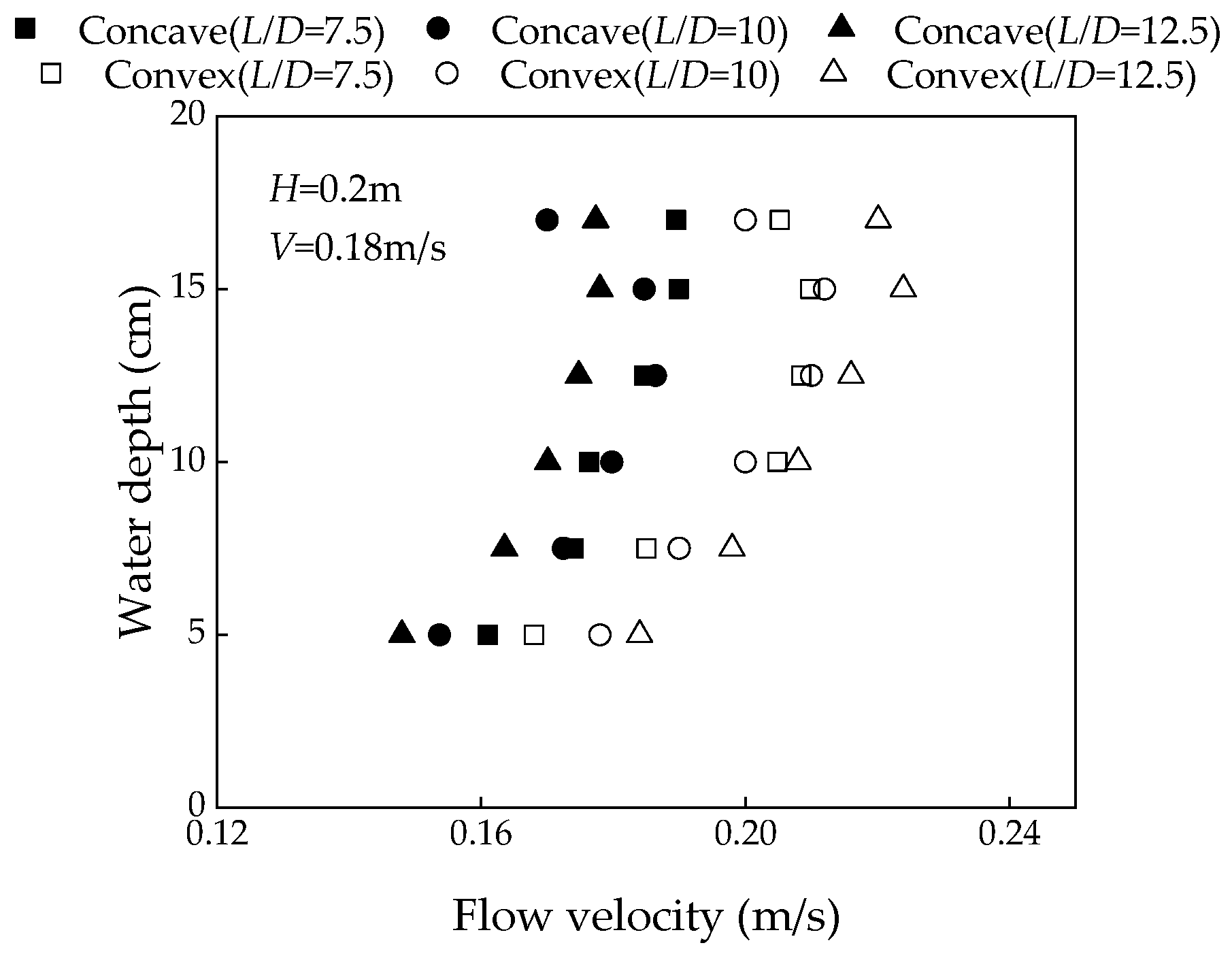

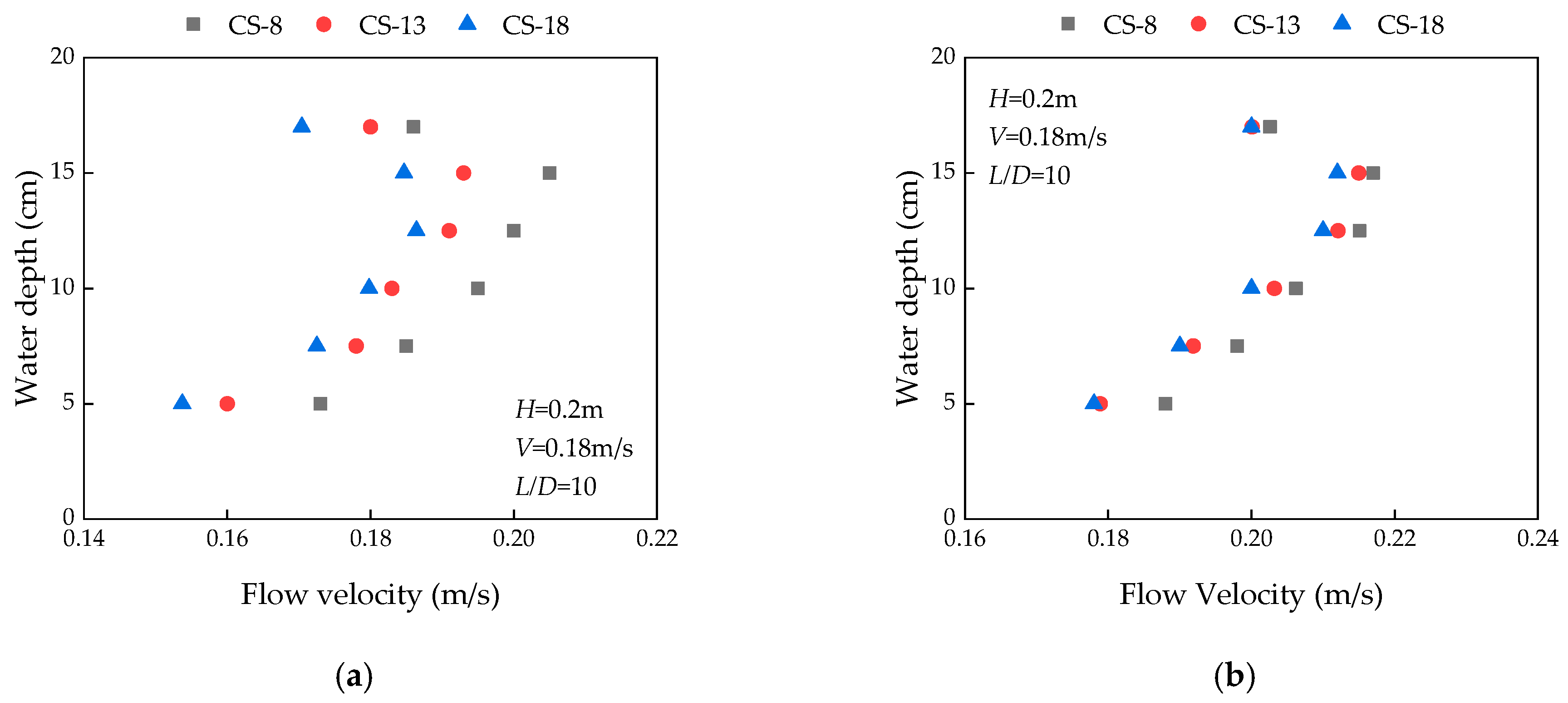
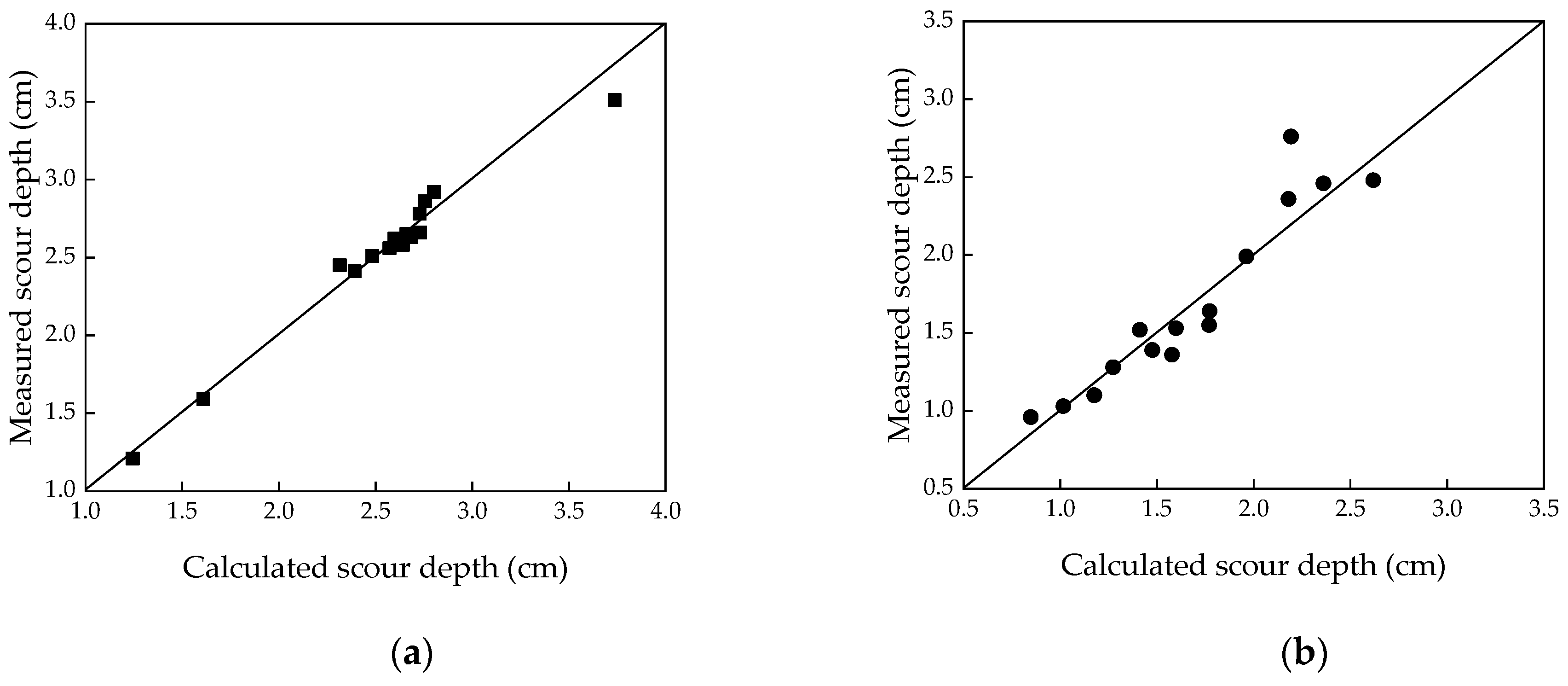
| Experiment Runs | Pier Location Cross-Section | Approach Flow Depth H (m) | Approach Flow Velocity V (m/s) | Pier Diameter D (m) | Pier Spacing L (m) |
|---|---|---|---|---|---|
| A1 | CS-8 | 0.2 | 0.18 | 0.02 | 0.15 |
| A2 | CS-8 | 0.2 | 0.18 | 0.02 | 0.20 |
| A3 | CS-8 | 0.2 | 0.18 | 0.02 | 0.25 |
| A4 | CS-13 | 0.2 | 0.18 | 0.02 | 0.15 |
| A5 | CS-13 | 0.2 | 0.18 | 0.02 | 0.20 |
| A6 | CS-13 | 0.2 | 0.18 | 0.02 | 0.25 |
| A7 | CS-18 | 0.2 | 0.18 | 0.02 | 0.06 |
| A8 | CS-18 | 0.2 | 0.18 | 0.02 | 0.08 |
| A9 | CS-18 | 0.2 | 0.18 | 0.02 | 0.11 |
| A10 | CS-18 | 0.2 | 0.18 | 0.02 | 0.15 |
| A11 | CS-18 | 0.2 | 0.18 | 0.02 | 0.20 |
| A12 | CS-18 | 0.2 | 0.18 | 0.02 | 0.25 |
| A13 | CS-18 | 0.2 | 0.15 | 0.02 | 0.15 |
| A14 | CS-18 | 0.2 | 0.16 | 0.02 | 0.15 |
| A15 | CS-18 | 0.2 | 0.17 | 0.02 | 0.15 |
| A16 | CS-18 | 0.2 | 0.20 | 0.02 | 0.10 |
| B1 | CS-8 | 0.2 | 0.18 | 0.02 | 0.15 |
| B2 | CS-8 | 0.2 | 0.18 | 0.02 | 0.20 |
| B3 | CS-8 | 0.2 | 0.18 | 0.02 | 0.25 |
Disclaimer/Publisher’s Note: The statements, opinions and data contained in all publications are solely those of the individual author(s) and contributor(s) and not of MDPI and/or the editor(s). MDPI and/or the editor(s) disclaim responsibility for any injury to people or property resulting from any ideas, methods, instructions or products referred to in the content. |
© 2023 by the authors. Licensee MDPI, Basel, Switzerland. This article is an open access article distributed under the terms and conditions of the Creative Commons Attribution (CC BY) license (https://creativecommons.org/licenses/by/4.0/).
Share and Cite
Song, F.; Wang, J.; Zhang, Z.; Cheng, T.; Li, G.; Sui, J. Local Scour around Side-by-Side Double Piers in Channel Bends under Ice-Covered Conditions—An Experimental Study. Water 2023, 15, 2317. https://doi.org/10.3390/w15132317
Song F, Wang J, Zhang Z, Cheng T, Li G, Sui J. Local Scour around Side-by-Side Double Piers in Channel Bends under Ice-Covered Conditions—An Experimental Study. Water. 2023; 15(13):2317. https://doi.org/10.3390/w15132317
Chicago/Turabian StyleSong, Feihu, Jun Wang, Zhenhua Zhang, Tiejie Cheng, Guowei Li, and Jueyi Sui. 2023. "Local Scour around Side-by-Side Double Piers in Channel Bends under Ice-Covered Conditions—An Experimental Study" Water 15, no. 13: 2317. https://doi.org/10.3390/w15132317
APA StyleSong, F., Wang, J., Zhang, Z., Cheng, T., Li, G., & Sui, J. (2023). Local Scour around Side-by-Side Double Piers in Channel Bends under Ice-Covered Conditions—An Experimental Study. Water, 15(13), 2317. https://doi.org/10.3390/w15132317








